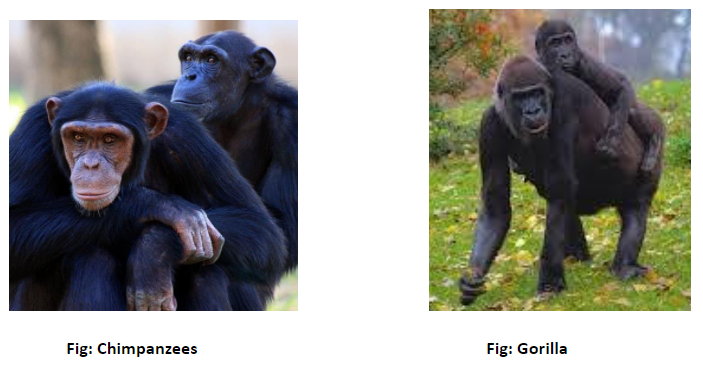
The family Pongidae includes _________
A. Fossils and modern man
B. Fossil forms and present-day gorillas
C. Gorilla and chimpanzee
D. Both (B) and (C)
Answer
583.5k+ views
Hint: The family Pongidae includes the animal’s named Gorilla, chimpanzees.
They have black hair and skin. They do not have tails.
Short muzzles, a prominent brow ridge, large nostrils, small eyes, and ears are present on their face.
Moreover, Chimpanzees have white whiskers on their chin.
Like humans, chimpanzees have flat faces.
They rely more on their eyes, sense of sight than the nose, sense of smell. They have naked skin without hair on their palms, hands, and soles of feet.

Complete answer: Pongidae is a fossil primate that contains gorillas and chimpanzees.
They are also called "great apes".
The pongid skull contains the following features:
1. Sulcus present behind the brow ridges
2. Presence of a protruding occipital region
3. Presence of large and bony eye sockets
4. Presence of large nasal opening
5. Presence of constriction behind the orbital region
6. Presence of stout facial bones
7. Presence of diastema
The difference between Pongidae with humans are as follows:
So, the correct answer is option C. Gorilla and chimpanzee.
Note: Earlier, humans alone (with their extinct forebears) were placed in Hominidae, and the great apes were positioned in a different family, Pongidae.
However, morphological and molecular investigations now indicate that humans are closely related to chimpanzees, while gorillas are more distant and orangutans more distant still.
They have black hair and skin. They do not have tails.
Short muzzles, a prominent brow ridge, large nostrils, small eyes, and ears are present on their face.
Moreover, Chimpanzees have white whiskers on their chin.
Like humans, chimpanzees have flat faces.
They rely more on their eyes, sense of sight than the nose, sense of smell. They have naked skin without hair on their palms, hands, and soles of feet.

Complete answer: Pongidae is a fossil primate that contains gorillas and chimpanzees.
They are also called "great apes".
The pongid skull contains the following features:
1. Sulcus present behind the brow ridges
2. Presence of a protruding occipital region
3. Presence of large and bony eye sockets
4. Presence of large nasal opening
5. Presence of constriction behind the orbital region
6. Presence of stout facial bones
7. Presence of diastema
The difference between Pongidae with humans are as follows:
| Characters | Pongidae | Humans |
| Arms | Arms longer than the legs | Arms are shorter than the legs |
| Orientation of scapula | The scapula has an orientation for supporting the body weight beneath the arms | The scapula is oriented for holding the arms by the side |
| Digit pattern | Digits are long and curved | Digits are shorter and straight |
| Function of pelvis | The pelvis is shaped to support the legs and trunk in the bent-over posture | The pelvis is shaped to support the legs and trunk in a vertical position |
| Position of knees | Knees do not lock the legs | Knees lock the legs straight |
| Size and shape of the pelvis | The pelvis is relatively large | The pelvis is much shorter and bowl-shaped |
| Iliac pillar shape | The iliac pillar is elongated | The iliac crest is oriented to the side and slanted |
So, the correct answer is option C. Gorilla and chimpanzee.
Note: Earlier, humans alone (with their extinct forebears) were placed in Hominidae, and the great apes were positioned in a different family, Pongidae.
However, morphological and molecular investigations now indicate that humans are closely related to chimpanzees, while gorillas are more distant and orangutans more distant still.
Recently Updated Pages
The number of solutions in x in 02pi for which sqrt class 12 maths CBSE

Write any two methods of preparation of phenol Give class 12 chemistry CBSE

Differentiate between action potential and resting class 12 biology CBSE

Two plane mirrors arranged at right angles to each class 12 physics CBSE

Which of the following molecules is are chiral A I class 12 chemistry CBSE

Name different types of neurons and give one function class 12 biology CBSE

Trending doubts
One Metric ton is equal to kg A 10000 B 1000 C 100 class 11 physics CBSE

What is 1s 2s 2p 3s 3p class 11 chemistry CBSE

Discuss the various forms of bacteria class 11 biology CBSE

State the laws of reflection of light

Explain zero factorial class 11 maths CBSE

An example of chemosynthetic bacteria is A E coli B class 11 biology CBSE




